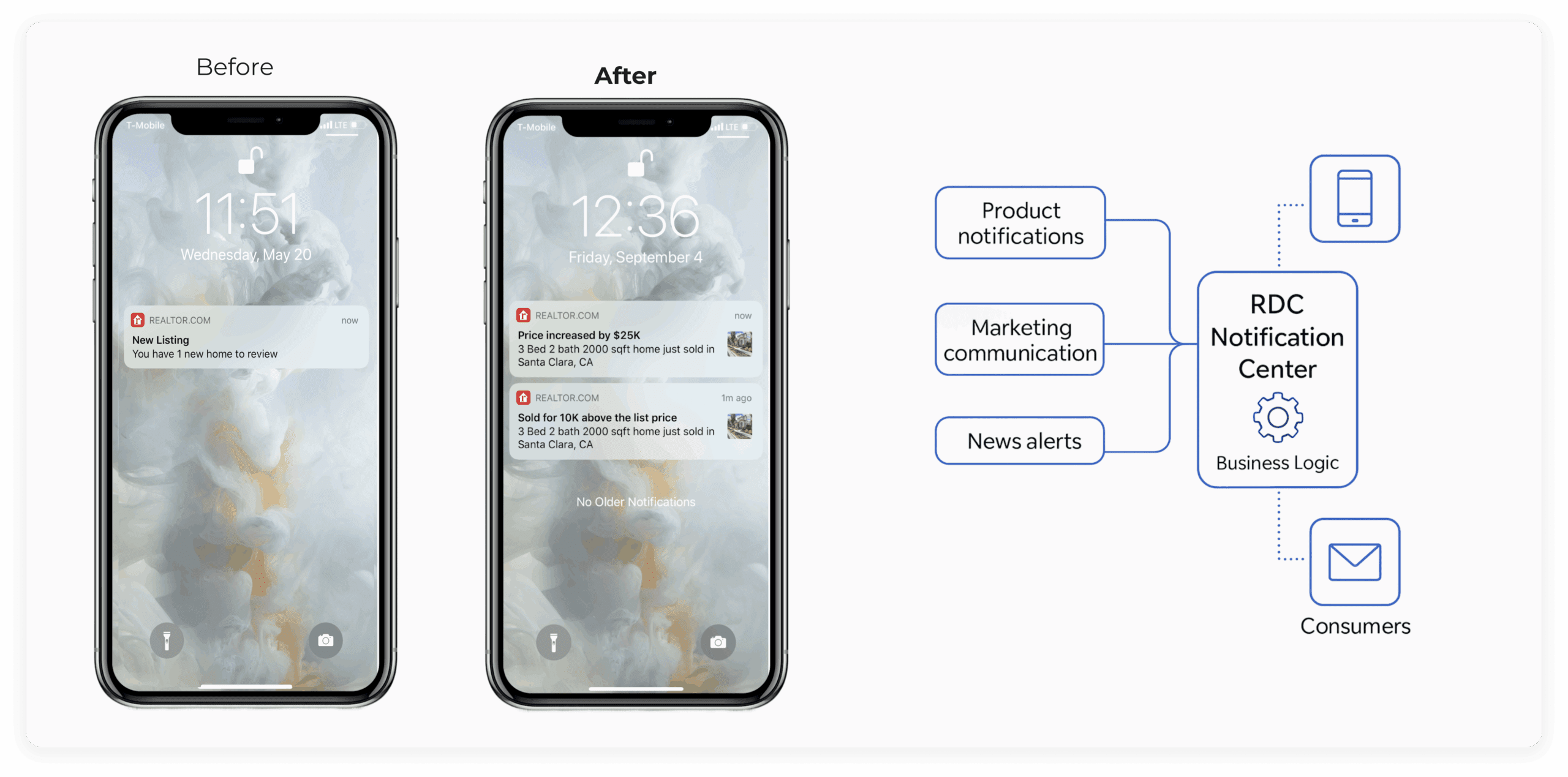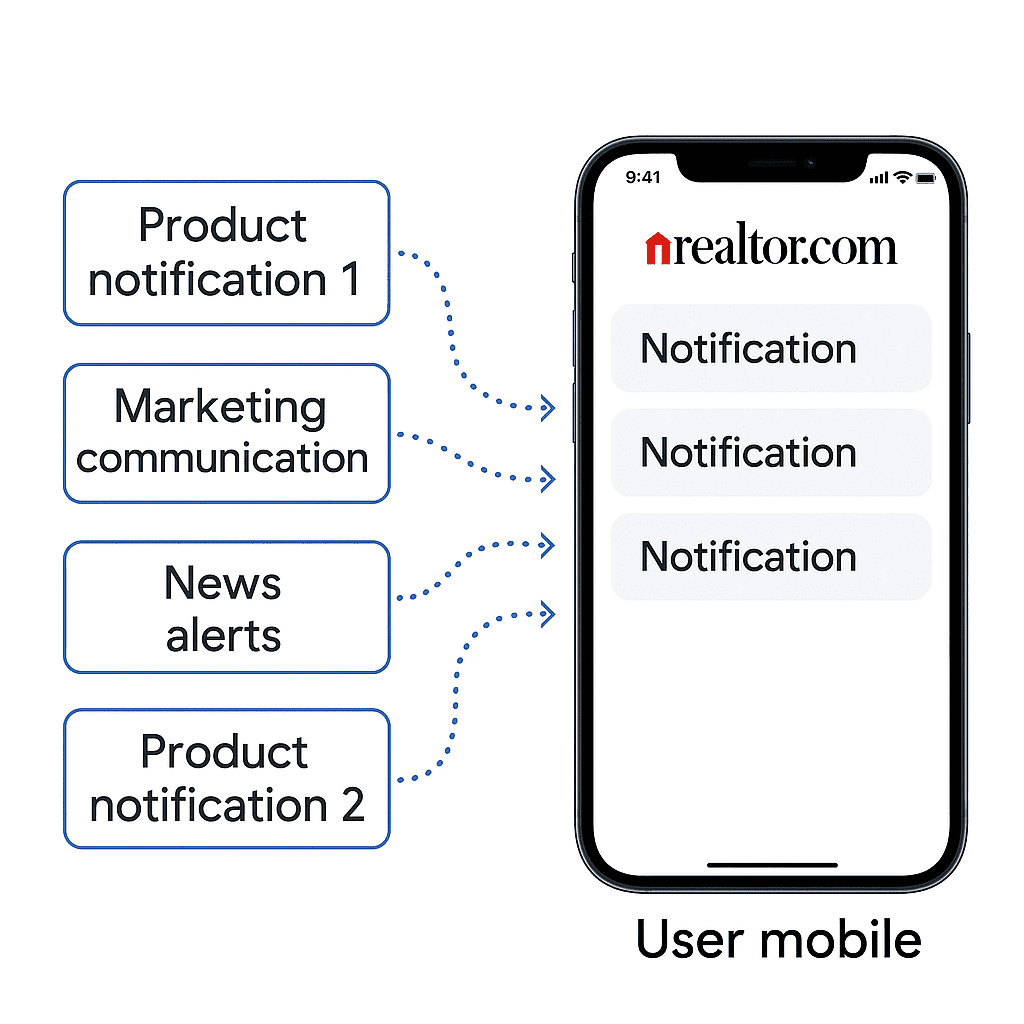RDC Notifications System Overhaul
As part of the Journey Orchestration & Recommendations (JOR) initiative at RDC, I led a critical overhaul of the Notifications/Alerts system, transforming it from a fragmented, slow, and low-relevance feature into one of the top three most-valued features 🏆 by consumers. I built and led a cross-functional mission team that reimagined notifications as a foundational service, not just a feature.

The Problem: A Broken Notification Experience
Despite notifications being a critical user touchpoint, RDC’s alerts system was falling short—slow, irrelevant, and fragmented across channels. 22-minute average delivery delays, irrelevant content, and inconsistent cross-platform experiences drove down user satisfaction. The system operated more as a patchwork feature than a strategic engagement platform.
We saw the consequences play out across key indicators:
-
App Store ratings tied to alerts plateaued at 3.5 stars
-
User complaints around missed or spammy alerts climbed
-
Only 5 basic filters powered alerts, ignoring the breadth of user-defined search preferences
This fractured experience degraded user trust and weakened our competitive position in a fast-moving market.


Fragmented Delivery = Frustrated Users
Marketing and product teams were sending alerts independently—using separate tools with no shared rules or coordination:
Marketing pushed emails and mobile notifications through Braze
Product triggered alerts directly via platform services like APNS
This led to:
Redundant and conflicting notifications reaching the same user
Periods of over-communication (spam) followed by critical gaps in delivery
No centralized source of truth or throttling logic to manage load or urgency
The lack of unified governance not only hurt user trust, but also made measurement and optimization nearly impossible across touchpoints.
My Role & Strategy
Established and championed the vision of Notifications-as-a-Service, transforming alerts into a centralized platform that eliminated duplication and communication gaps.
Redefined success metrics, aligning teams around retention over vanity KPIs like open rates to drive sustained user value.
Formed and led a high-impact cross-functional mission team, collaborating with 7 departments including Apps, Web, Data, Marketing, UX, and Backend.
Aligned stakeholders on a unified delivery roadmap, driving clarity on milestones, ownership, and timelines.
Prioritized speed, relevance and UX as foundational pillars, tying product strategy directly to company-wide OKRs.
Empowered each team with clear wins, fostering ownership and accountability without top-down mandates.

📈 Product Impact: Outcome Metrics
User Value & Experience
🌟 ↑70% improvement in CSAT for alerts — driven by faster, more relevant notifications
🙌 ↓60% reduction in consumer complaints — reduced noise, increased trust
⭐ App Store rating improved from 3.5★ to 4.7★ — directly tied to notification experience overhaul
🔁 +20% lift in 7- and 28-day retention — through rich, personalized push alerts (A/B validated)
Platform Leverage & Internal Adoption
🧩 Built notifications as a centralized platform service — powering product, ops, and marketing use cases
🔄 Unified delivery engine — eliminated duplication and gaps across mobile/web
🧪 Scaled internal adoption — 5+ teams integrated via standardized APIs
🚦 Delivery governance logic — throttling and prioritization ensure high-value, non-spammy alerts
Performance & Competitive Advantage
⚡ Reduced alert latency from 22 min → <5 sec — now faster than Redfin/Zillow in 90% of markets
🎯 Expanded filter coverage from 5 → 50+ — addressing 95%+ of user-defined search criteria
📈 Scaled alert volume 5x YoY — with no drop in CSAT or app reviews
🏆 Positioned as a top-3 RDC product strength — recognized at the executive level
Key Learnings

KPI alignment matters
Moving beyond vanity metrics (e.g., open rate) to business-impacting metrics like retention transformed how teams prioritized.

Speed + Relevance = Trust
Timely, useful alerts aren’t just engagement tools—they earn consumer trust by meeting urgent needs in a seller’s market.

Platform thinking scales
Rebuilding notifications as an internal platform created leverage across teams and future products.